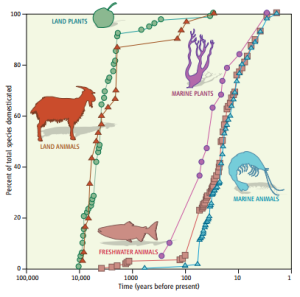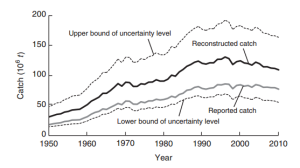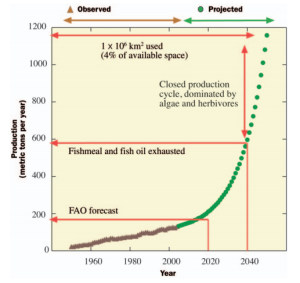Tag: Mariculture
Creating global food security – Domesticating Poseidon?
By Nickolas James Hawkes
The human population is projected to reach 9.7 billion by 2050 (UN, 2015), falling within most estimates of a global carrying capacity of 8 to 16 billion people (UNEP, 2012); however, an enormous amount of uncertainty exists in these estimates. The uncertainty stems from both natural constraints and the choices we make (Cohen, 1995). This then raises the question: How do we meet the demands of an increasing population? We can increase our food production (a technological solution, Duarte et al., 2009), lower our trophic level (change our diets, Cohen, 1995; Bonhommeau et al., 2013) and (or) ensure a more equitable distribution of resources globally (social solution, Godfray et al. 2010). Furthermore, the problem only increases in complexity when one adds the effects of climate change and resource use into the picture, as the competition for land, water and energy competes with the land available for food production (Godfray et al., 2010).
In this blog post, I wish to explore the role of the ocean in providing us food in the future, as the freshwater available for agriculture (directly and indirectly) and the consequences of increased consumption places limits on how many people agriculture can support (Duarte et al. 2009). It is interesting that our domestication of animals and plants, of landscapes and entire ecosystems (Kareiva et al., 2007) is mainly terrestrial, and that our domestication of the ocean only really “began” 100 years ago (figure 1, Duarte, Marbá and Holmer, 2007). Thus, the potential productivity of marine aquaculture – which will henceforth be defined as “mariculture” – and the smaller impact of water limitation (particularly if it is a “closed” system, see Duarte et al. 2009), provide powerful incentives.
Figure 1 (from Duarte, Marbá and Holmer, 2007). The domestication of terrestrial plants and animals began almost 10 000 years ago, whilst the domestication of marine species experienced tremendous growth in the 20th century.
You may wonder why I haven’t discussed fisheries, and the simple answer is that there is not much more “room” in expanding catches (i.e. several stocks are already overexploited, see FAO, 2014). This is reflected in the decreasing level of catches globally (figure 2, Pauly and Zeller, 2016), as well as the increase in the proportion of fisheries production used for direct human consumption (71% in the 1980s and 86% in 2012; FAO, 2014). It has also been estimated that the average recruitment capacity of global fish stocks has declined by 3% of the historical maximum per decade (Britten, Dowd & Worm, 2016). This food source, albeit “unlimited” if fished sustainably, can only support a limited amount of people, in a world of increasing people and demand. Thus a window of opportunity exists for aquaculture and mariculture to provide both food and commodities for humanity.
Figure 2 (from Pauly & Zeller, 2016). Figure showing catch per million tonnes over time with the reported catch (grey line) used in the FAO’s report (2014), and the reconstructed catch (black line). The reconstructed catch includes the reported catch plus estimates of unreported catches.
Mariculture has experienced a 10-fold increase in production in 30 years (Duarte et al., 2009), and domestication of both a wider variety of taxa and known species is occurring at rates much higher than terrestrial organisms (Duarte, Marbá and Holmer, 2007). This broader range of taxa has two important implications: One, it allows for polyculture, which can decrease the environmental impact (Neori et al. 2004), and two, it allows for a more diversified market (Duarte, Marbá and Holmer, 2007). What then are its limitations? A parallel in terrestrial agriculture, space, is likely to be one significant limitation in the future (Duarte et al., 2009). As production increases in parallel to demand, increased competition for space is an inevitable outcome. Then comes the challenge of creating closed or “integrated” food systems. This is actually a relatively simple idea, and involves using products from mariculture to feed mariculture (e.g. polyculture, Neori et al., 2004). As an example, if one was to use the maximum possible yield of fishmeal and oil to feed crab and fish mariculture (with the predicted growth rate of 7.5 % per year), production would be limited at 45 to 50 million metric tonnes per year around 2040 (figure 3, Duarte et al., 2009).
Figure 3 (from Duarte et al., 2009). Time-series showing bottlenecks and future challenges of marine food production. Observed values are depicted by brown triangles and predicted values are depicted by green circles. The predicted line is a function of 2005 levels of fish catches and harvest of macroalgal stocks, as well as mariculture’s current growth rate of 7.5% per year.
The future of mariculture certainly looks very bright, and may be the next food revolution in human history (Duarte et al., 2009). With that said, a parallel in agriculture, intensification, can bring increased risks of diseases, species introductions, loss of biodiversity and altered ecosystem services (Duarte, Marbá and Holmer, 2007; Béné et al., 2016). Thus, a sustainable model that optimises yield whilst minimising environmental impacts will be the way forward. I must also add that whilst technological solutions (e.g. polycultures and vertical farming) will aid in creating global food security, there is no single long-term solution. If productivity in food production does not “keep up” with an increasing population with increasing demands, pressure to seek short-term solutions will increase, potentially degrading the largest common of all (tragedy of the commons, Hardin, 1968). If we are to ensure sustainable and equitable food security for all, a multifaceted strategy is needed (Godfray et al., 2010).
References
- Béné, C., Arthur, R., Norbury, H., Allison, E. H., Beveridge, M., Bush, S., Campling, L., Leschen, W., Little, D., Squires, D., Thilsted, S. H., Troell, M. and Williams, M. (2016) Contribution of Fisheries and Aquaculture to Food Security and Poverty Reduction: Assessing the Current Evidence. World Development, 79, pp. 177-196.
- Bonhommeau, S., Dubroca, L., Le Pape, O., Barde, J., Kaplan, D. M., Chassot, E. and Nieblas, A. E. (2013) Eating up the world’s food web and the human trophic level. Proc Natl Acad Sci U S A, 110(51), pp. 20617-20.
- Britten, G. L., Dowd, M. and Worm, B. (2016) Changing recruitment capacity in global fish stocks. Proc Natl Acad Sci U S A, 113(1), pp. 134-9.
- Cohen, J. E. (1995) Population growth and earth’s human carrying capacity. Science, 269(5222), pp. 341-6.
- Duarte, C. M., Holmer, M., Olsen, Y., Soto, D., Marba, N., Guiu, J., Black, K. and Karakassis, I. (2009) Will the Oceans Help Feed Humanity? . BioScience, 59, pp. 967-76.
- Duarte, C. M., Marba, N. and Holmer, M. (2007) Ecology. Rapid domestication of marine species. Science, 316(5823), pp. 382-3.
- FAO (2014) The State of World Fisheries and Aquaculture 2014. in,Rome.
- Godfray, H. C., Beddington, J. R., Crute, I. R., Haddad, L., Lawrence, D., Muir, J. F., Pretty, J., Robinson, S., Thomas, S. M. and Toulmin, C. (2010) Food security: the challenge of feeding 9 billion people. Science, 327(5967), pp. 812-8.
- Hardin, G. (1968) The Tragedy of the Commons. Science, 162(3859), pp. 1243-8.
- Kareiva, P., Watts, S., McDonald, R. and Boucher, T. (2007) Domesticated nature: shaping landscapes and ecosystems for human welfare. Science, 316(5833), pp. 1866-9.
- Neori, A., Chopin, T., Troell, M., Buschmann, A. H., Kraemer, G. P., Halling, C., Shpigel, M. and Yarish, C. (2004) Integrated aquaculture: rationale, evolution and state of the art emphasizing seweed biofiltration in modern mariculture. Aquaculture, 231, pp. 361-391.
- Pauly, D. and Zeller, D. (2016) Catch reconstructions reveal that global marine fisheries catches are higher than reported and declining. Nat Commun, 7, pp. 10244.
- United Nations Department of Economic and Social Affaris / Population Division. (2015) World Population Prospects. New York: United Nations.
- United Nations Environment Programme. Global Environmental Alert Service (GEAS). (2012) One Planet, How Many People? A Review of Earth’s Carrying Capacity.


